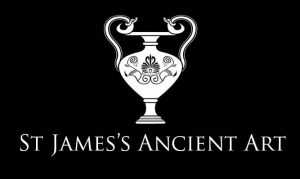The Romans frequently utilised the functional and decorative capabilities of glass to produce a wide array of objects. Glass flasks, such as this example, were used as containers for ointments, powders, balms, and other expensive liquids such as perfumes: the small mouth of the bottle is ideal for slow, careful pouring, while glass was preferred for holding liquids, due to its non-porous, non-absorbent nature.
The nomenclature developed due to a similarity in form to the flattened spherical vessels utilised by pilgrims to carry water on their travels. The shape is also sometimes referred to as ‘lentoid’ meaning ‘lens-shaped’. This particular form appears to be a predecessor to twin-handled pilgrim flasks, which became commonplace later in the 3rd and 4th centuries. These later iterations also often feature additionally applied trailing.
To learn more about Roman glass, visit our relevant post: How It Was Made: Roman Glass.








